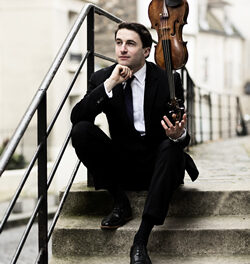One doesn’t often get the chance to hear the double bass as a solo instrument, but the Greensboro Symphony Orchestra‘s “Italian Inspirations” concert Thursday night in Dana Auditorium at Guilford College provided that opportunity. The soloist was Xavier Foley, a young artist (graduating with a BA in music from the Curtis Institute in 2016) who has accumulated quite a few awards, including the 2018 Avery Fisher Career Grant.
The fitting vehicle Foley used to wow the audience was the Concerto No. 2 for Double Bass in B minor by Giovanni Bottesini (Italy, 1821-89). Bottesini is certainly not a composer of great renown now, but during his lifetime he was known as a virtuoso player (the “Paganini” of the instrument) as well as a famous conductor. (Verdi chose him to conduct the 1871 premiere of Aida in Cairo.) He also contributed a great deal to technique for the double bass.
The concerto is scored for solo and string orchestra and is in three movements. The opening Allegro provided a wonderful conduit to display Foley’s amazing lyricism and facility. The cadenza was a compendium of show-stopping virtuosity. Sometimes, the bassist would treat the instrument as a dancing partner, sometimes as a lover. The slow middle movement provided him a gorgeous melody to display the lovely timbre of the instrument. The agitated finale shot his playing into the stratosphere, utilizing some of the highest notes on the instrument.
The audience was excited to hear such masterful playing, and Foley treated the audience to an original composition, the “Irish Fantasy.” The four-minute work was chocked full of distinctive rhythms – in short, it is a fiddling piece for the bass.
Franz Schubert (Austria, 1797-1828) penned his Symphony No. 4 in C minor, D. 417 in 1816, when the composer was only 19 years old. It was not presented to the public until 1849, more than 20 years after his death.
The opening Adagio introduction is clearly beholden to “The Representation of Chaos” from Haydn’s oratorio The Creation: same key, same chord, same opening motive – a nice bow to the master. The following Allegro was stern and the GSO, under the direction of music director Dmitri Sitkovetsky, grabbed the drama for all it was worth.
The conductor began the slow lyric movement without a baton, providing a “soft glove” to the music. The simple melody begins in the strings, but the music calls for the winds for backup. A recurring more animated section provides contrast. Here, great ensemble in the winds and a nice conversation between the strings and winds distinguishes the music.
The third movement Allegro vivace Menuetto (really should have been called a Scherzo) presents some complicated rhythms, adding spice to the “dance.” The perky Trio again featured great playing from the winds.
The final Allegro provides a quasi “Beethoven” conclusion, with full orchestra taking part in the drama. Although Schubert labelled the symphony “Tragic,” the overall mood, while at times dark, is more buoyant than that identity would imply.
The evening opened with a colorful reading of Gli uccelli (The Birds, 1928) written by Ottorino Respighi (Italy, 1879-1936) for small orchestra. The five movements are based somewhat on Baroque pieces, including compositions by Bernardo Pasquini (Italy, 1637-1710), Jacques de Callot (France, 1692-1735), Jean-Philippe Rameau (France, 1683-1764), and an anonymous English composer. However, the composition sounds entirely like Respighi.
Many in the audience were probably familiar with the triumphant tune employed in the Prélude (by Pasquini), but not sure where they had heard it. The opening provides for an upbeat intro to the following section loaded lots of bird calls.
The subsequent four “bird” movements gave a showcase to the impressive talents of the GSO wind section. “La colomba” (The Dove) featured lots of harp (sensitively played by Helen Rifas) and oboe (performed by Mary Ashley Barret) accompanied by soft murmuring from the strings. Kelly Burke‘s gentle clarinet playing joined in.
You can probably guess what the “La gallina” (The Hen) sounds like; clucking sounds emanate from the strings with oboe riffs. Flute (played by Debra Reuter-Pivetta), oboe, clarinet, and bassoon (Carol L. Bernstorf) come together to join in the fun.
“L’usignuolo” (The Nightingale) is a calm movement, again featuring great playing by the principal winds and a tender (and exposed) solo by horn (Robert Campbell) and celesta (Nancy Johnson).
Again, you can imagine what the final “Il cucù” (The Cuckoo) sounds like. The characteristic bird calls pop out of purring and sweeping string flourishes. The movement closes with the return of the opening triumphant tune. Great playing by the entire orchestra in a wonderful concert opener.
The program is repeated Saturday evening. Please visit our sidebar for details.












